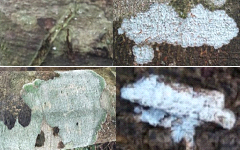
Lichen as bioindicator of air quality at buffer zone of Banjarbaru town
Abstract
ABSTRACT
Air pollution is one of the main issues faced by urban areas. Therefore, morphological characteristic and colony coverage of lichen growing at different scale air-polluted area could become as a bioindicator of their air quality. This research aims to determine the condition of lichen in spots located at near and far from the main road (width ± 29 meter) in urban area at Banjarbaru town. This research used descriptive method with purposive sampling technique. Sample were obtained from 2 plots those were far and near the main road, each plot represented by samples from 5 different trees (densed canopy with minimum DBH at 25 cm). Lichens were taken at 50-150 cm above ground level using 20x20 cm quadrant plastic frame. Observation variables include the number and shape of colonies, color and type of thallus, and percentage of thallus cover. We determined 13 colonies from spots far from the main road (500-600 meter from main road). Lichen dominated by green to bluish color, thallus consist of crustose and foliose, and the average percentage of thallus cover was 28.01%. While from that near the main road (14-250 meter from main road), we determined 14 colonies predominantly consisted of white crustose lichens, and the average percentage of thallus cover was 10.01%. Traffic intensity showed to have significant effect on lichens community. The main difference can be seen from morphology and colony coverage. Based on this result, lichen can be used as bioindicator of air quality, especially air pollution caused by motorized vehicles.
Keywords
Full Text:
pdfReferences
Asih, S. M., Jumari, & Murningsih. (2013). Keanekaragaman Jenis Lichenes Epifit pada Hutan Kopi dan Hutan Campuran di Nglimut Gonoharjo Kendal. Jurnal Biologi, 2(2), 27–36.
Baderan, D. W. K., Uno, W. D., & Usuli, Y. (2013). Lumut Kerak Sebagai Bioindikator Pencemaran Udara (Studi Kasus di Jalan H.B. Jasin Kelurahan Dulalowo Kecamatan Kota Tengah Kota Gorontalo) (p. 8). Universitas Negeri Gorontalo.
Chandra, R. H. (2015). Akumulasi Timbal (Pb) Dan Keanekaragaman Jenis Lichen di Taman Kota Medan. Jurnal Biologi Lingkungan, 2(1), 2550–1305.
Das, K., Dey, U., Bhaumik, R., Datta, J. K., & Mondal, N. K. (2011). A Comparative Study of Lichen Biochemistry and Air Pollution Status of Urban, Semi Urban and Industrial Area of Hooghly and Burdwan District, West Bengal. Journal of Stress Physiology & Biochemistry, 7(4), 311–323.
Fatma, Y., Mahanal, S., & Sari, M. S. (2017). Keanekaragaman Familia Physciaceae dan Lobariaceae di Taman Hutan Raya Raden Soerjo sebagai Bahan Ajar pada Mata Kuliah Mikrobiologi. Jurnal Pendidikan, 2(2), 179–185.
Islam, Y. C. (2007). Respon Lumut Kerak pada Vegetasi Pohon Sebagai Indikator Pencemaran Udara di Kebun Raya Bogor dan Hutan Kota Manggala Wana Bhakti. Institut Pertanian Bogor.
Ismiyati, Marlita, D., & Saidah, D. (2014). Pencemaran Udara Akibat Emisi Gas Buang Kendaraan Bermotor. Jurnal Manajemen Transportasi & Logistik (JMTransLog), 01(03), 241–248.
Jannah, M., & Hudayah. (2019). Keanekaragaman Lichen sebagai Biomonitoring Kualitas Hutan di Lereng Selatan Gunung Merapi Yogyakarta. Scripta Biologica, 5(3), 1–14.
Kurniasih, S., Munarti, Prasaja, D., & Estari, A. A. (2020). Potensi Liken sebagai Bioindikator Kualitas Udara di Kawasan Sentul Bogor. Jurnal Penelitian Ekosistem Dipterokarpa, 6(1), 17–24.
Murningsih, & Mafazaa, H. (2016). Jenis-Jenis Lichen di Kampus Undip Semarang. Bioma, 18(1), 20–29.
Muziansyah, D., Sulistyorini, R., & Sebayang, S. (2015). Model Emisi Gas Buangan Kendaraan Bermotor Akibat Aktivitas Transportasi (Studi Kasus: Terminal Pasar Bawah Ramayana Kota Bandar Lampung). JRSDD, 3(1), 57–70.
Nasriyati, T., Murningsih, & Utami, S. (2018). Morfologi Talus Lichen Dirinaria Picta (Sw.) Schaer. Ex Clem pada Tingkat Kepadatan Lalu Lintas yang Berbeda di Kota Semarang. Jurnal Akademika Biologi, 7(4), 20–27.
Noer, I. (2004). Bioindikator Sebagai Alat untuk Menengarai Adanya Pencemaran Udara. Forum Komunikasi ingkungan III.
Nurjanah, S., Anitasari, Y., Mubaidullah, S., & Bashri, A. (2013). Keragaman dan Kemampuan Lichen Menyerap Air sebagai Bioindikator Pencemaran Udara di Kediri. Proceeding Biology Education Conference, 1–8.
Pratiwi, S. U. (2015). Karakteristik Bioindikator Cisadane : Kajian Pemanfaatan Makrobentik Untuk Menilai Kualitas Sungai Cisadane. Ecolab, 9(2), 47–104.
Rahardjanto, A., & Husamah. (2019). Bioindikator (Teori dan Aplikasi dalam Biomonitoring). UMM Press.
Rasyidah. (2018). Kelimpahan Lumut Kerak ( Lichens ) Sebagai Bioindikator Kualitas Udara Di Kawasan Perkotaan Kota Medan. Klorofil, 1(2), 88–92.
Roziaty, E. (2016). Kajian Lichen: Morfologi, Habitat, dan Bioindikator Kualitas Udara Ambien Akibat Polusi Kendaraan Bermotor. Bioeksperimen, 1(2), 54–66.
Sumarlin, Maheng, M. D., & Rosdiana. (2016). ACE 3-008 Pemantauan Kualitas Udara Perkotaan Menggunakan Lumut Kerak (Lichen). Prosiding Seminar ACE, 22–23.
Susilaradeya, D. P. (2010). Lumut Kerak Sebagai Bioindikator Pencemaran Udara. Artikel Ilmiah Bidang Lingkungan, 2.
DOI: https://doi.org/10.20886/glm.2021.2.1.54-65
Refbacks
- There are currently no refbacks.
Copyright (c) 2021 Jurnal GALAM

This work is licensed under a Creative Commons Attribution-NonCommercial-ShareAlike 4.0 International License.
Balai Penelitian dan Pengembangan Lingkungan Hidup dan Kehutanan Banjarbaru
Jl. A. Yani Km. 28,7 Guntung Manggis - Landasan Ulin - Banjarbaru Kalimantan Selatan 70721, Kotak Pos 1065, Telp. (0511) 4707872, Fax. (0511) 4707872
e-mail : galamjurnal@gmail.com
Website : http://banjarbaru.litbang.menlhk.go.id/
Jurnal Galam Terindex di :

eISSN 2723-5084, pISSN 2723-4924
Jurnal Galam All content is licensed under a This work is licensed under a Creative Commons Attribution-NonCommercial-ShareAlike 4.0 International License
Copyright © 2020 | Jurnal Galam






